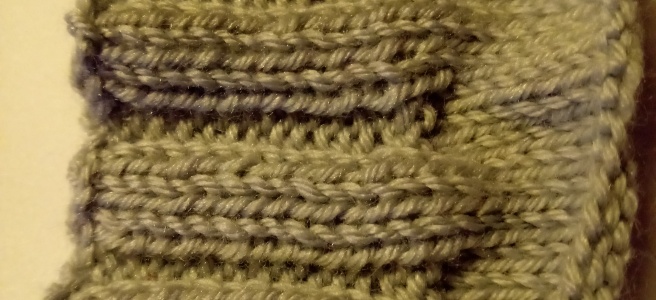These last months, I’ve been experimenting with AI. Quite naturally, I decided to test available free AI tools to see whether artificial intelligence knows anything about knitting. Over these last 20 years, knitting bloggers have written thousands of posts about their knitting experience. Surely, enough content to train AI on, so what’s the result ? Quite good indeed!
I’ve experimented with Bard, ChatGPT (free version), Copilot + Perplexity AI. Perplexity AI and Copilot I found pretty much useless. The only thing that’s good about them is that they give you their references. But it remains really basic as the references they use are themselves basic. ChatGPT and Bard fare much better.
So why use AI ? It’s up to you. It all depends on what you’re interested in. The interface is pretty much the same as any chat application. The only difference is that there is no human behind it, only an informatic program. And what you write is called a prompt. Online, you find all sorts of advice on which are the best “prompts” to get interesting answers from AI. A prompt is basically a question. And despite what people selling “the best prompts” would like you to believe, you don’t actually need their lengthy and expensive courses. What’s great about AI is that you can ask it questions in plain English. You don’t need any knowledge of a programming language. So feel free to keep it basic, as long as you provide the AI with the context of your question.
Concrete example of the use of AI to improve my knitting:
My last question to Bard about knitting was the following :
“Knitting. Choosing the best bind off. I’m mending a knit. I need a somewhat flexible but very sturdy bind off . Which one should I choose?”
Notice that I am giving the AI the general context of my question by this single word : Knitting. Than I am specifying this context further by indicating I want to choose a bind off.
AI is not magic. If you don’t provide a context, it doesn’t know what you’re talking about. So when you type in your first prompt, giving it the general context is important to guide it in the right direction. After giving this context (simply typing “knitting” is usually enough), just “talk” with the AI as you would if you were talking to a human. In my last interaction with Bard, Bard suggested several bind-offs I could use, including the Kitchener bind-off. And if I used the Kitchener stitch when grafting socks, I didn’t know there was such a thing as a Kitchener bind-off. So I continued the conversation asking for several clarifications : “How do you work the Kitchener bind off?“, ” Can I work the Kitchener bind off straight after a 3/3 rib or should I knit a plain row first“, etc.
After the first prompt, you can indeed add as many other questions as you see fit and you needn’t repeat the context, Once the “conversation” is launched the AI is able to recognise the topic. So whether or not your first prompt was the best possible or not just doesn’t matter! And if the AI is not providing you with any meaningful answer, give it feedback such as “this is not at all what I was interested jn, what I actually want to know is….”, “you don’t get it at all, what I mean is …..”. See? Keeping it basic and to the point.
My initial prompt wasn’t all that good as it mentioned I was mending a knit, but in fact the mending part was irrelevant : I had picked up some stitches, unraveled the piece that was torn and now was looking for a very sturdy bind-off. So when its first answer came with answers related to mending, I just told him the mending was already done and what I was looking for was a very sturdy bind-off. The quality of your prompts isn’t all that important, you can rectify them at any time, simply by giving the AI an improved prompt or specifying what you are actually looking for. Just like you would in a actual conversation. The only difference being bluntness : there is no human behind whose feelings you need to take into account!
I couldn’t make sense of Bard’s indications on how to work the Kitchener bind-off, so I found a tutorial online and knitted a swatch. Turns out Bard was right about the Kitchener bind-off being sturdy. I will be employing it in the future, especially for half-mitt. I really like its esthetic.
Several prompts you might find useful
- Translate. All you need to do is copy and paste the text you want it to translate and type ” translate into…”. O how I wish this was available when I was copying paragraph after paragraph on Google Translate patterns I had bought in Norwegian!
(Disclaimer : official translations are under copyright. You can use such a translation for your personal use, but you can’t sell it, publish it online or share it). - List. I asked chatGPT to list me the 10 best books to learn how to design knitwear. Not only did it come with 10 books, but when I watched a video from the Unapologetic Knitter and another lady – both of them professional tech knit editors – which were the books they were recommending ? You guessed it right, these very same books !
I like this prompt to discover new things. Like I asked chatGPT to list me 10 contemporary Finnish knitwear designers and not only did it list me 10 designers, but it gave me details about their work. I tend to use “list me 10”, but of course you can choose whatever number you wish. The sky is the limit! - Give me the pros and cons of solution A. Especially useful when you want to assess whether your choices are good or bad. AIs are programmed to have a rather rosy worldview and be very supportive of your ideas. Which is good for your self-esteem but can result in answers that are as uncontroversial as can be . An alternative prompt can be: criticise solution A, explain to me what are its drawbacks.
In my previous example, I used the following prompt to gain a broader perspective on the use of the kitchener bind-off: “Why is choosing a kitchener bind-off usually a bad idea to finish a flat knit ? Why do many people avoid it despite mastering this technique?” (Note that Bard hadn’t stated that it was “usually a bad idea” or that “many people are avoiding it, but I was getting rather useless answers such as “it depends on your taste”.) - Answer me as….. You can have AI endorse roles (chemist, knitwear designer, climate change activist, historian) and have it answer as a professional would – or rather as the AI thinks a professional would. Fun to test as the answers do vary!
Cross-reference via Youtube, Google or your knitting books
Artificial intelligence is not a reliable source of information. It’s not in fact “intelligent”, it’s a very impressive simulation of human intelligence. As of now, artificial is still prone to hallucinations. In humans, hallucinations mean that your hear, feel or see things that are not actually there. It’s the same with artificial intelligence : it sometimes gives you informations that don’t correspond to reality ; and these crap answers is what is called hallucinations. In my experience, you can sometimes put in back on track by answering: “How sure are you about this ? Could you be hallucinating? Please answer the previous question step by step and with 0 randomness“. Specifying you want it to work “step by step” is a way of having it spend more time computing its answer, 0 randomness means you want it to be as accurate as possible.
Whatever good you get at prompting though, artificial intelligence can only give you answers based on the set of data it got trained on. For instance, few bloggers have dvelved deeply into breed specific knitting, so I don’t expect AI to provide me with good answers. Indeed it doesn’t. Likewise, I asked ChatGPT to translate simple sentences into Wolof. The results were appalling! I would point out its mistake and then I got the usual “I am sorry for the confusion. You are right, …..” and it gave me yet another completely crap translation! Though Wolof is widely spoken, nowadays it is not widely written, making its training data set all the smaller. At the opposite end are programming languages such as Python. I’ve been use AI to begin learning the basics about Python and haven’t encountered a single hallucination.
Back to my example of looking out for a sturdy bind-off : its instructions on how to work a Kitchener bind-off I didn’t understand at all. Bard wasn’t using the usual “insert the tapestry needle purlwise/knitwise”, which made matters worse. But it could also be that the instructions were just gibberish – aka an AI hallucination. So I looked up in my books to see how to work this bind-off. I didn’t find anything, even in Vogue Knitting (the most recent version of Vogue Knitting, the ultimate knitting book). I then searched on YouTube and here it was, the “Kitchener bind-off on one needle” video by Andrea Mowry in all its glory!

The bind-off has been worked after the ribbing.
This bind-off is only a good option on a rather small number
of stitches as you are using a single thread that you are sewing in.
This picture is just there for illustration purpose, I made a few mistakes
along the way. Swatch could look better, but I was just experimenting.
